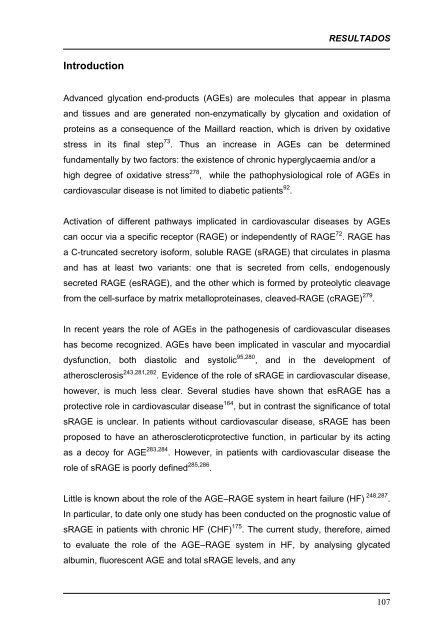INTRODUCCIÓN: REVISIÓN CRITICA DEL PROBLEMA
INTRODUCCIÓN: REVISIÓN CRITICA DEL PROBLEMA
INTRODUCCIÓN: REVISIÓN CRITICA DEL PROBLEMA
You also want an ePaper? Increase the reach of your titles
YUMPU automatically turns print PDFs into web optimized ePapers that Google loves.
Introduction<br />
RESULTADOS<br />
Advanced glycation end-products (AGEs) are molecules that appear in plasma<br />
and tissues and are generated non-enzymatically by glycation and oxidation of<br />
proteins as a consequence of the Maillard reaction, which is driven by oxidative<br />
stress in its final step 73 . Thus an increase in AGEs can be determined<br />
fundamentally by two factors: the existence of chronic hyperglycaemia and/or a<br />
high degree of oxidative stress 278 , while the pathophysiological role of AGEs in<br />
cardiovascular disease is not limited to diabetic patients 92 .<br />
Activation of different pathways implicated in cardiovascular diseases by AGEs<br />
can occur via a specific receptor (RAGE) or independently of RAGE 72 . RAGE has<br />
a C-truncated secretory isoform, soluble RAGE (sRAGE) that circulates in plasma<br />
and has at least two variants: one that is secreted from cells, endogenously<br />
secreted RAGE (esRAGE), and the other which is formed by proteolytic cleavage<br />
from the cell-surface by matrix metalloproteinases, cleaved-RAGE (cRAGE) 279 .<br />
In recent years the role of AGEs in the pathogenesis of cardiovascular diseases<br />
has become recognized. AGEs have been implicated in vascular and myocardial<br />
dysfunction, both diastolic and systolic 95,280 , and in the development of<br />
atherosclerosis 243,281,282 . Evidence of the role of sRAGE in cardiovascular disease,<br />
however, is much less clear. Several studies have shown that esRAGE has a<br />
protective role in cardiovascular disease 164 , but in contrast the significance of total<br />
sRAGE is unclear. In patients without cardiovascular disease, sRAGE has been<br />
proposed to have an atheroscleroticprotective function, in particular by its acting<br />
as a decoy for AGE 283,284 . However, in patients with cardiovascular disease the<br />
role of sRAGE is poorly defined 285,286 .<br />
Little is known about the role of the AGE–RAGE system in heart failure (HF) 248,287 .<br />
In particular, to date only one study has been conducted on the prognostic value of<br />
sRAGE in patients with chronic HF (CHF) 175 . The current study, therefore, aimed<br />
to evaluate the role of the AGE–RAGE system in HF, by analysing glycated<br />
albumin, fluorescent AGE and total sRAGE levels, and any<br />
107
















